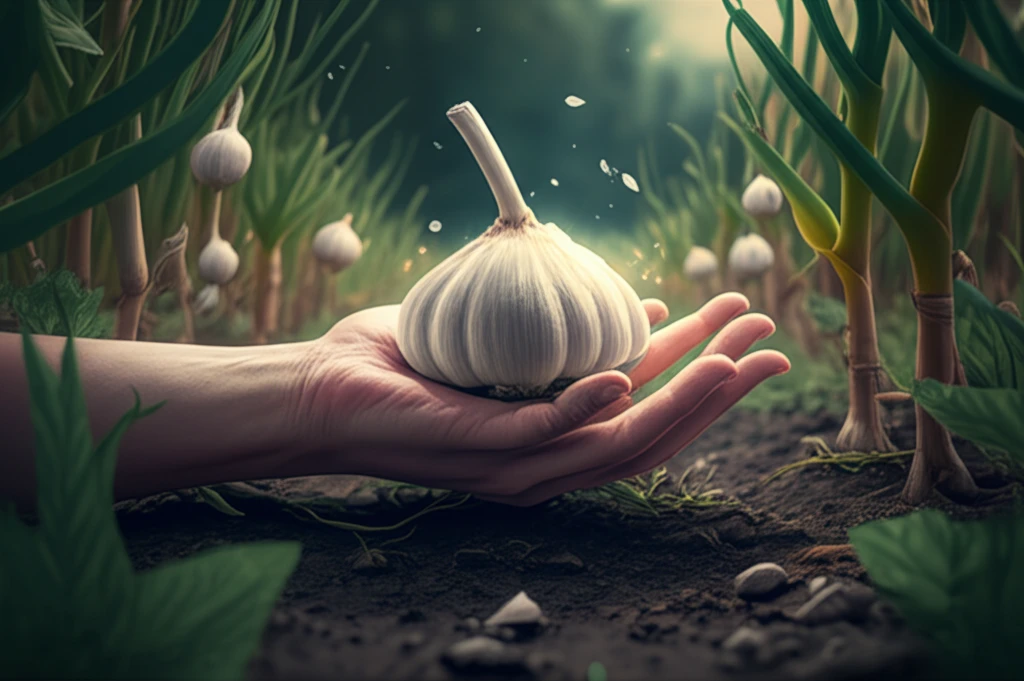
Unlocking Garlic's Potential: How to Grow Bigger, Better Bulbs
"A deep dive into the science of garlic cultivation, revealing the secrets to maximizing your yield through careful selection and strategic growing techniques."
Garlic (Allium sativum L.) isn't just a kitchen staple; it's a fascinating crop with a rich history and complex genetics. While many home gardeners appreciate its pungent flavor and health benefits, few realize the potential for significantly increasing their yield through informed cultivation practices. This article delves into the research behind garlic yield optimization, providing practical insights for both novice and experienced growers.
The key to unlocking garlic's full potential lies in understanding the intricate relationships between various plant characteristics and their impact on bulb size and overall yield. By analyzing character associations and employing path analysis, we can identify the most influential traits and tailor our growing strategies accordingly. This approach moves beyond simple trial and error, offering a scientifically grounded method for achieving impressive results.
Imagine consistently harvesting garlic with larger, more flavorful bulbs, all thanks to a deeper understanding of the plant's growth dynamics. This guide bridges the gap between complex agricultural research and practical gardening, empowering you to make data-driven decisions that will transform your garlic patch.
Decoding Garlic's Genetic Blueprint: Key Traits for a Bountiful Harvest

Agricultural research, particularly the study "CHARACTER ASSOCIATION AND PATH ANALYSIS IN GARLIC (Allium sativum L) FOR YIELD AND ITS ATTRIBUTES," highlights the importance of specific traits that directly influence garlic yield. Conducted at the Central Institute of Temperate Horticulture in Srinagar, India, this research examined twenty diverse garlic genotypes over two growing seasons (2010 and 2011). The goal was to pinpoint the characteristics that contribute most significantly to total bulb yield. This research targeted diverse range of garlic samples across different genetic backgrounds to reduce biases and improve result of findings. The research is applicable for home gardener's because it provide simple ways to improve garlic yeild.
- Plant Height: Taller plants generally produce larger bulbs. This is likely due to increased photosynthetic capacity, allowing the plant to generate more energy for bulb development.
- Number of Leaves per Plant: A greater number of leaves translates to more surface area for photosynthesis, fueling bulb growth.
- Pseudo-Stem Length: A longer pseudo-stem, which is the tightly wrapped base of the leaves, is also associated with higher yields. This may indicate a more robust and vigorous plant.
- Bulb Weight: This is the most obvious indicator. Selecting for heavier bulbs in each generation leads to a cumulative increase in yield over time.
- Number of Cloves per Bulb: While not always directly correlated with bulb size, a higher number of cloves can increase the overall harvest.
Putting Research into Practice: A Path to Garlic Growing Success
The research discussed here provides a valuable framework for optimizing your garlic growing practices. By focusing on key traits like plant height, leaf number, and bulb weight, and equatorial bulb diameter you can select for higher-yielding garlic varieties, implement cultivation techniques that promote robust growth, and ultimately enjoy a more abundant and flavorful harvest. Consider this knowledge as your guide to a more successful and fulfilling garlic-growing journey.
